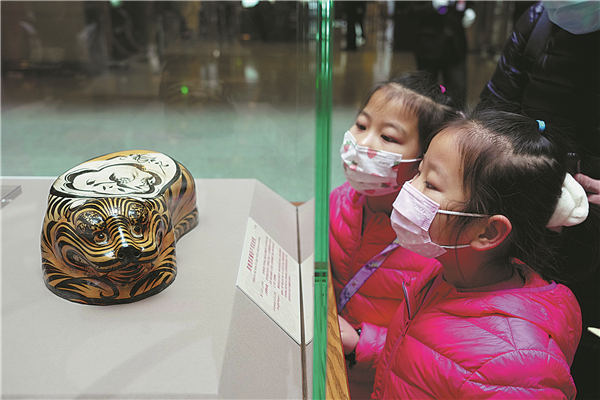

An exhibition celebrating the upcoming Year of the Tiger, according to the Chinese zodiac, is now on at the Shanghai Museum, showcasing six objects from its collection and four borrowed pieces from Japan's Kyushu National Museum. Five of the exhibits are being shown in Shanghai for the first time.
The exhibition opened on Jan 18 and will run until Feb 27.
The first piece that greets visitors in the museum lobby is a ceramic pillow from the 12th century that is in the form of a tiger and painted with images of a wild goose and reeds. Such tiger pillows were popular in the Jin Dynasty (1115-1234), especially in the Yellow River region, where people believed they could fend off nightmares and ensure a good night's sleep, says Chen Jie, deputy director of the Shanghai Museum.
In China, the cultural representation of tigers is often one of docility and amicability instead of ferociousness, notes Chen.
On a gilt mat weight that dates back to the Western Han Dynasty (206 BC-AD 24), a tiger is seen crouching and wearing a collar.
In the Qin (221-206 BC) and Han (206 BC-AD 220) dynasties, people usually sat on matted floors, and their loose sleeves and long hems of their robes would often pull at the corners of the mat and cause inconvenience. As such, animal-shaped weights, which were usually filled with lead, were placed at the four corners of mats to address the problem. This object alone weighs 3.6 kilograms, Chen says.
"As a natural habitat of tigers, China preserves multiple subspecies and has many tiger-themed archaeological relics, historical accounts and mythical folktales," says Yang Zhigang, director of the Shanghai Museum.
This museum and the Kyushu National Museum are jointly hosting the exhibition to celebrate the 50th anniversary of the normalization of China-Japan diplomatic relations. Yang notes that Japan has a longstanding custom of revering tigers despite its lack of indigenous ones.
"The Japanese tiger artworks often reflect exotic taste, as we will find in the two large Imari (Japanese porcelain) blue-and-white porcelain dishes on display," Yang says.
Four paintings of the tiger, one by Shen Quan (1682-1760), another a wood print from Zhangzhou, Fujian province, from the Qing Dynasty (1644-1911), and two by Japanese artists of the 18th century, are displayed on the electronic screens at the museum, allowing audiences to appreciate the details.
Tigers in folk tradition are often represented as guardians that ward off disasters and evil spirits. By highlighting "joyful tigers" in this show, the museums hope to send a message of optimism and solidarity in the global battle against the COVID-19 pandemic, according to Yang and Shimatani Hiroyuki, executive director of the Kyushu National Museum.
The Shanghai Museum has also developed a new series of merchandise and cartoon images inspired by the exhibits for people to share on social media.
"We hope people can enjoy the show and take the souvenirs with them," Chen says.
If you go
A Joyful New Year: China-Japan Exhibition Celebrating the Year of the Tiger
Jan 18-Feb 27. Shanghai Museum, 201 Renmin Avenue, Huangpu district, Shanghai. 021-6372-3500.